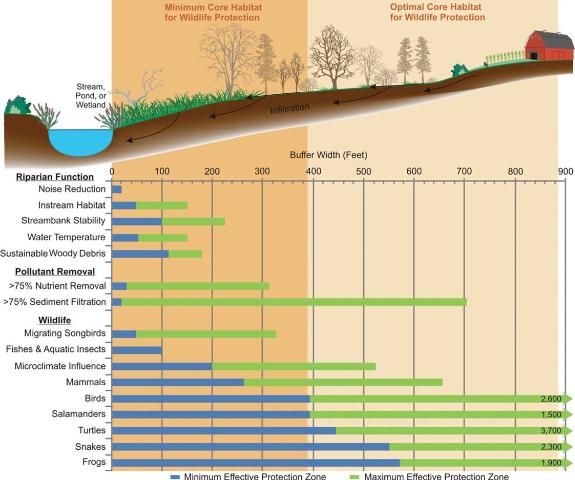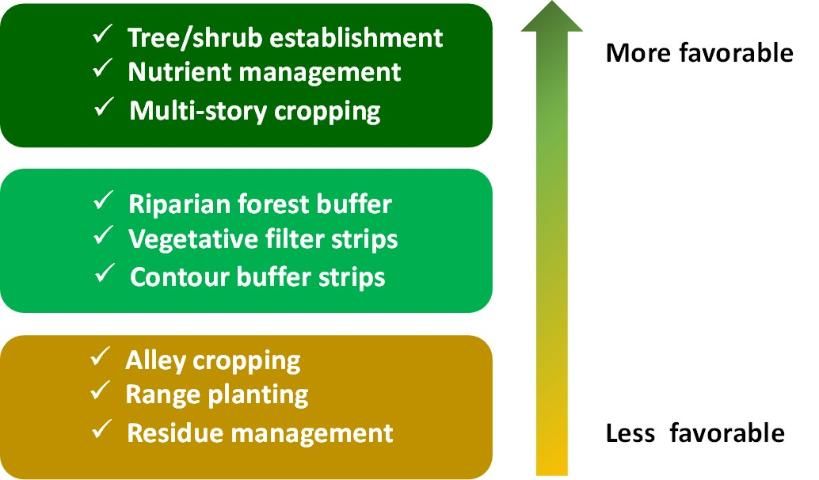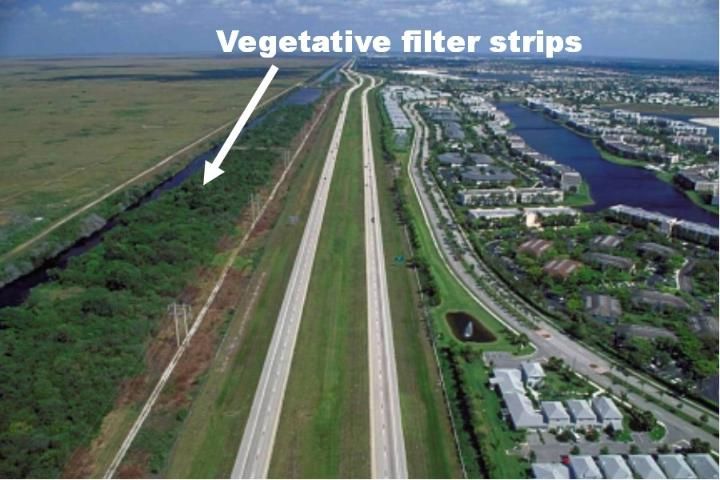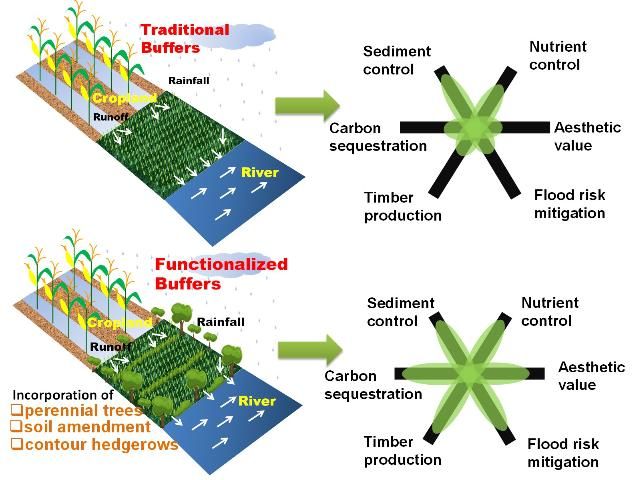Introduction
Riparian buffers and Vegetative Filter Strips (VFSs) are both Best Management Practices (BMPs) recommended by USDA and EPA because of their potential for nonpoint source pollution control (USDA-NRCS 1999; EPA 2006). These buffers improve water quality by intercepting and slowing runoff. This action prevents nutrients, sediments, and contaminants from entering nearby waters. While the primary functions of riparian buffers and VFSs are the same, their practice definitions are different. VFSs are mostly implanted vegetation areas that require regular maintenance to preserve the dense vegetation. VFSs are usually located within and between agricultural fields and waterways (rivers and streams). Riparian buffers, which tend to be larger than VFSs, can be created or unplanned, and contain mostly brushy or woody vegetation that emerges near streams or channels. For decades research on VFSs and riparian buffers has focused on pollutant removal. However, as society confronts the consequences of global warming, deteriorating water quality, and impoverished biodiversity, there is a growing urgency to develop and expand these buffers' multifunctional ecosystem services. In this context, these buffers should not be seen as operating independently from the surrounding land; instead, they must be regarded as an integrated part of the landscape. Figure 1 illustrates riparian buffer systems as the "engine that drives important natural functions like food availability and quality, access to clean water and habitat diversity" (Southeastern Wisconsin Regional Planning Commission 2010). Based on this concept, there is a need to change the way buffers are designed and evaluated in order to maximize their broader benefits to our society.

Credit: Southeastern Wisconsin Regional Planning Commission
One of the key ecosystem functions that buffer systems support is the trapping of nutrients, sediments, or pesticides. However, limited information is available on other potential co-benefits associated with the use of buffers, particularly VFSs. This publication is intended to provide information on multiple ecosystem benefits provided by buffers (e.g., niche products production, carbon sequestration, and flood risk mitigation). Recommendations on future research needs necessary to enhance multiple ecosystem services and benefits of buffers are also provided.
Buffers' Multiple Ecosystem Services
Niche Products Production
Buffer strips are generally located along or around streams, lakes, ponds, or wetlands. Many of these areas feature high soil moisture and nutrient availability. Trees and shrubs are commonly incorporated with buffers as beneficial components of the filter system, especially in a riparian zone. In addition to intercepting and filtering pollutants, trees can also be harvested, providing additional value as a renewable fuel source, timber for construction, and fruits, nuts, and other products for small growers. This value can represent a different kind of opportunity for farmers who want to supplement their income. For example, tree species that could be incorporated into filter systems in the southeast region of the United States may also have other uses (USDA National Agroforestry Center, 2015). Pawpaw fruits can be used in jams and jellies and maple or ash can be used for timber. For more information about trees for Florida, please visit the UF/IFAS Extension sites (https://hort.ifas.ufl.edu/woody/selection.shtml).
Carbon Sequestration
There is a growing awareness of the adverse effects of greenhouse gases (GHG) and their potential impact on climate change. Recent studies suggest a few of the challenges of climate change can be effectively overcome by the storage of carbon in terrestrial carbon sinks via plants and soils. Compared to other Natural Resources Conservation Service (NRCS) practices, such as tree/shrub establishment, the potential to sequester large amounts of carbon in buffers is not well understood (Figure 2). For more information, please visit the following website: https://www.nrcs.usda.gov/wps/portal/nrcs/detailfull/national/air/quality/?cid=stelprdb1044982.
Although carbon sequestration in traditional buffers (i.e., without perennial or woody vegetation) is not well understood, a number of approaches have the potential to improve the capacity of buffers to sequester carbon. One promising approach is to incorporate perennial vegetation into traditional buffer systems since perennial plants sequester and store greater amounts of carbon than annual plants do. A recent study indicates that a riparian buffer system consisting of mixtures of annual and perennial species sequestered significantly greater amounts of carbon compared with crop fields or an annual grass buffer alone (Fortier et al. 2015). This finding provides further evidence that incorporating perennial vegetation in strategic locations within traditional buffer systems creates opportunities to expand the systems' capacity for carbon sequestration. The use of soil amendments such as the charcoal by-product biochar presents another potential means of promoting greater carbon sequestration through buffer systems. Since biochar is highly resistant to degradation, it can provide a long-term sink for carbon storage in the soil. In addition, recent studies also indicate that biochar can be effective in controlling the fate of fertilizer-nitrogen and reducing the unintended environmental consequences associated with N losses via gas emission, overland flow, and leaching.

Credit: L. Wu
Flood Risk Mitigation
Buffers, specifically VFSs, are one of the most frequently used stormwater management tools in urbanized areas. Many stormwater practitioners perceive VFSs mostly as a water quality management practice and underestimate the value of VFS systems as effective tools for peak discharge control, channel protection, and bank stabilization. While research data related to this function are still limited, computational and modeling results clearly indicate that VFSs can be effective in controlling peak discharge rates and mitigating flood risks. For example, a recent study (Ballinger 2011) indicates that although VFSs represent a relatively small portion of land, they can help mitigate the impact of intense rainfall, especially in drier summer months (e.g., subtropical storms). Similarly, researchers in another study (Liu et al. 2014) developed a community scale simulation model to quantify the effectiveness of different Green Infrastructure (GI) on reducing the volume and peak flow of urban flooding. Results show that vegetated surfaces make the greatest contribution to reducing storm runoff in the community. That said, the reduction capacity for a single GI facility is limited, especially in bigger storm events. However, integrated GI configuration (e.g., incorporating the hedgerows of native perennial plants with traditional VFSs) has shown significant reduction capability by reducing the total runoff and peak flow rate by more than 25% and 10%, respectively. These results suggest that integrated VFS systems have the potential to act as a low-impact development and resilient management practice in urban areas. In Florida, VFSs have been used as a stormwater management practice to preserve or restore predevelopment hydrology, increase dry-weather base flow, and reduce bankfull flooding frequency (Figure 3).

Credit: South Florida Water Management District
Summary and Recommendations
Generally, addressing other ecosystem functions of buffers implies a trade-off in terms of total land that must be retired from production in favor of protection, especially in an agricultural context. The arguments in this paper support the hypothesis that buffers, if properly managed, should not be considered as unproductive landscape designed for water quality control, but as part of a productive landscape with multiple ecosystem functions and potential economic benefits (Figure 4).

Credit: L. Wu
Enhancement of the efficacy of buffers' multiple ecosystem services requires additional research and development of more effective management strategies. The following list of items, intended to present challenges for researchers, engineers, and decision makers, was designed to meet these goals.
- For researchers, there is a critical need to understand the functions, conflicts, and interactions between diffuse pollution and other services. This will allow the development of improved and more effective strategies that can maximize the benefits of buffers to our society. For example, there is a need to look into mechanisms that control the nutrient cycling process in buffer systems. This fundamental knowledge is important for us to better manage buffer soil to provide a wide range of ecosystem services, such as pesticide degradation, carbon sequestration, and high biodiversity support. There is an additional need to quantify carbon and nitrogen sequestration in buffer systems.
- For engineers or farmers, there is a need to embrace the complexities of managing unfamiliar integrated buffer systems. Unlike conventional buffer systems, they are not designed to be fully controlled. Managing integrated buffer systems requires more flexibility, effective communication, and risk management.
- For decision makers, there is a need to encompass measures of performance beyond the finances of a single utility or political entity. New tools will be needed to quantify non-monetary benefits and create incentives for organizations to adopt approaches that lead to better overall outcomes. For example, an ecological-economic model using the Bayesian belief network (a statistical model which uses a directed acyclic graph to represent the conditional dependencies of each variable) should be considered to assess and value the delivery of ecosystem services from the buffer system.
- For educators, there is a need to provide interdisciplinary education in multiple areas. Successfully managed integrated buffer systems will require the integration of knowledge and tools from basic sciences, such as hydrology, microbiology, ecology, and geochemistry, with applications of computer skills.
References
Asbjornsen, H., V. Hernandez-Santana, M. Liebman, J. Bayala, J. Chen, M. Helmers, C. K. Ong, and L. A. Schulte. 2014. "Targeting perennial vegetation in agricultural landscapes for enhancing ecosystem services." Renewable Agriculture and Food Systems 29: 101–25.
Ballinger, J. 2011. "Natural buffer placement and downstream flood mitigation in rural Hawke's Bay, New Zealand." Master's Thesis, Victoria University of Wellington.
Cramer, W., A. Bondeau, F. I. Woodward, I. C. Prentice, R. A. Betts, V. Brovkin, and P. M. Cox. 2001. "Global response of terrestrial ecosystem structure and function to CO2 and climate change: Results from six dynamic global vegetation models." Global Change Biology 7: 357–73.
Davis, A. P., W. F. Hunt, R. G. Traver, and M. Clar. 2009. "Bioretention technology: Overview of current practice and future needs." Journal of Environmental Engineering 135: 109–17.
Deletic, A., and T. D. Fletcher. 2006. "Performance of grass filters used for stormwater treatment—A field and modelling study." Journal of Hydrology 317: 261–75.
Dillaha, T. A. 1989. "Vegetative filter strips for agricultural non-point source pollution control." Transactions of the American Society of Agricultural Engineers 32: 513–19.
EPA. 2006. "Buffers and vegetative filter strips." http://water.epa.gov/type/watersheds/named/msbasin/upload/2006_8_24_msbasin_symposia_ia_session4-2.pdf. Accessed October 29, 2015
Florida Trees. University of Florida. 2010. "Tree Recommendation Tool." https://floridatrees.ifas.ufl.edu/FloridaTrees/ExpertSystem.html. (No longer available online.)
Fortier, J., B. Truax, D. Gagnon, and F. Lambert. 2015. "Biomass carbon, nitrogen and phosphorus stocks in hybrid poplar buffers, herbaceous buffers and natural woodlots in the riparian zone on agricultural land." Journal of Environmental Management 154: 333–45.
Kimble, J. M., R. Lal, and R. F. Follett. 2002. Agricultural Practices and Policies for Carbon Sequestration in Soil. Boca Raton: CRC Press, 100–102.
Liu, W., W. Chen, and C. Peng. 2014. "Assessing the effectiveness of green infrastructures on urban flooding reduction: A community scale study." Ecological Modelling 291: 6–14.
Matovic, D. 2011. "Biochar as a viable carbon sequestration option: Global and Canadian perspective." Energy 36: 2011–16.
McCracken, D. I., L. J. Cole, W. Harrison, and D. Robertson. 2012. "Improving the farmland biodiversity value of riparian buffer strips: Conflicts and compromises." Journal of Environmental Quality 41: 355–63.
Muñoz-Carpena, R., J. E. Parsons, and J. W. Gilliam. 1999. "Modeling hydrology and sediment transport in vegetative filter strips." Journal of Hydrology 214: 111–29.
National Agroforestry Center. USDA. 2015. “Why add edible and floral plants to riparian forest buffers?’ https://floridatrees.ifas.ufl.edu/FloridaTrees/ExpertSystem.html. (No longer available online.)
Peluso, V. F., and A. Marshall. 2002. "Best management practices for south Florida urban stormwater management systems (Technical Publication Reg-044)." West Palm Beach FL: South Florida Water Management District, Everglades Stormwater Program. https://www.sfwmd.gov/document/reg-004-best-management-practices-south-florida-urban-stormwater-management-systems. Accessed December 30, 2024.
Southeastern Wisconsin Regional Planning Commission. 2010. "Managing the water's edge—Making natural connections." http://www.sewrpc.org/SEWRPCFiles/Environment/RecentPublications/ManagingtheWatersEdge-brochure.pdf. Accessed October 29, 2015.
South Florida Water Management District. 2002. "Best management practices for south Florida urban stormwater management systems." http://www.sfwmd.gov/portal/page/portal/xrepository/sfwmd_repository_pdf/bmp_manual.pdf Accessed October 29, 2015
USDA-NRCS. 1999. "The national conservation buffer initiative." Washington: USDA National Resources Conservation Service, 53.